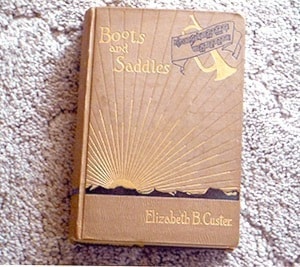This book, recently turned up in Quesnel, was published by Harper and Brothers in 1885. That’s 128 years ago – about the time of the Cariboo gold rush. It was written by General Custer’s wife who, in 1873, went west with her husband and the 7th Cavalry, to Dakota, to protect the Northern Pacific Railroad builders who were constantly pushing west.
The railroad from Memphis ended at Yankton, Dakota and the 800 – 900 men (full strength would have been 1,200 men) disembarked.
There were no facilities there except what the regiment had brought and as they put up their tents, a howling blizzard arrived. They were not accustomed or equipped for snow, coming from the deep south, and all suffered badly. Yankton, a town nearby, came to help in the morning.
The entire regiment marched and rode about 15 miles per day including the camp followers, meeting friendly or aggressive natives (fear of the unknown tribes was terrifying) until they reached Bismark and settled into Fort Abe Lincoln.
During the long winter in quarters, Gen. Custer studied the Napoleonic wars to analyze what went right or wrong and to surmise what he might learn from that conflict.
Mrs. Custer goes into considerable detail as to what being a civilian was like in the rough and tumble life on the central plains among native bands. A soldier was ordered to guard her but if death seemed obvious he was to shoot her.
The regiment was there for a year and supplying it was a major problem as wild game was scarce and cattle had to be driven hundreds of miles through hostile tribes. Extreme heat, huge grasshopper swarms and wolves and bears were daily problems. In the east, officers’ wives could get domestic help easily but on the frontier help was scarce. A servant lady, dressed as a man, drove ox teams but reverted to being a lady, did laundry and saved her money. A soldier considered her a good catch and married her. At her death in later years, she turned out to be a man and her husband shot himself, he was so upset.
Natives coming to barter displayed blond scalps upsetting the whites. Their dress and decoration contained two themes – the killing and scalping of warriors and the capture of ponies.
It is amazing that a piano was brought in, in those circumstances.
The regiment was ordered west to combat the warring tribes under Sitting Bull and consisted of 1,200 men and 1,700 horses in a column two miles long. Steamers carried supplies.
Some boats carried Springfield rifles bought from Canadian traders which the tribes used against the army. Bands shot at other steamers such that they had to shield the boats with metal sheets.
At the Little Big Horn battle, the 7th Cavalry was considered equal to 1,200 indians but ran into hundreds more than that. Custer’s last stand was on June 25, but word
of the disaster did
not reach Bismark until July 5.
A trip to the battle site, walking and reading about the chain of events makes a great historical vacation as the country has not changed much. Other battle sites are nearby – each with a different story.
Sitting Bull escaped to Canada, but that is another story.
Andy Motherwell is an amateur historian and regular Observer columnist.
